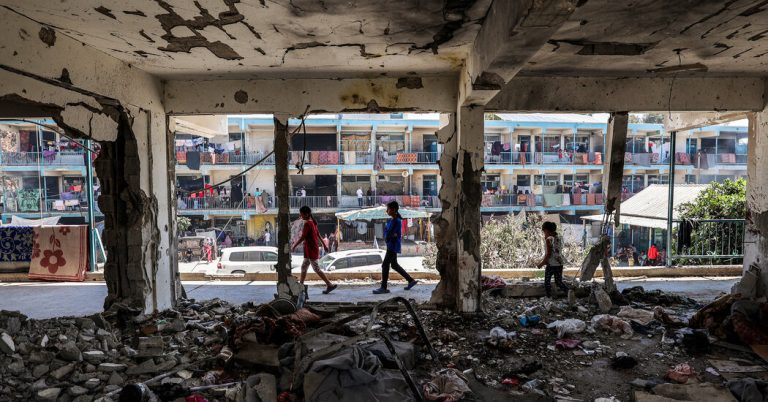As dawn broke on Thursday, Haitham Abu Ammar combed the ruins of the school that had become a refuge for him and thousands of other displaced Gazans. For hours, he helped people reunite the limbs of their loved ones.
“The most painful thing I have ever experienced was picking up these pieces of flesh with my hands,” said Mr Abu Ammar, a 27-year-old construction worker. “I never thought I’d have to do something like this.”
Early Thursday, Israeli airstrikes hit the school compound, killing dozens of people — including at least nine militants, the Israeli military said.
During the day, bodies and mutilated limbs pulled from the rubble were wrapped in blankets, piled into truck beds and driven to the Al Aqsa Martyrs Hospital, the last major medical facility still operating in central Gaza.
The Israeli military described the airstrike as carefully planned. Rear Admiral Daniel Hagari told reporters that Israeli forces had tracked the militants in the school-turned-shelter for three days before opening fire.
“The Israeli army and the Shin Bet have found a solution to separate terrorists from those seeking refuge,” he said.
But accounts from both local and foreign doctors, as well as a visit to the hospital by The New York Times on Thursday afternoon, made it clear that civilians also died.
Outside the hospital mortuary, crowds gathered to weep and pray for the dead. Hospital corridors were filled with people begging for help, or at least some comfort.
A young girl with a bloody leg screamed, “Mom! Mom!” as her crying mother followed her down the hospital corridors.
The exact toll could not be verified, but Gaza’s health ministry said that of the approximately 40 people killed in the attack, 14 were children and nine were women. Later in the day, the Associated Press reported different numbers, saying at least 33 people had died, including three women and nine children, citing the hospital’s morgue.
Al Aqsa Martyrs Hospital has become a symbol not only of the heavy loss of life in central Gaza, but also of the growing sense of desperation among Gazans struggling to find a place there that is still safe.
In recent weeks, the area has swelled with people fleeing another Israeli offensive, this one in the southern town of Rafah. Before this offensive began, Rafah was the main refuge for civilians, at one point holding more than half the population of the Gaza Strip.
Then on Wednesday, Israel announced that it had launched a new operation against Hamas militants in central Gaza – the very place where many Gazans who had fled Rafah had ended up.
The strike at the school complex happened early the next day, around 2 am. It hit a building in a compound run by UNRWA, the UN’s main Palestinian aid agency in Gaza.
Since the Israeli offensive on Gaza began in October in retaliation for a Hamas-led offensive in Israel, such schools have been used to shelter Gazans forced from their homes by the fighting. Israel says Hamas hides its forces in civilian settings such as schools or hospitals, a charge the group denies.
In the last two days of the new military campaign, al-Aqsa has claimed 140 lives and hundreds of wounded, health workers said.
“It’s absolute chaos, because we have mass casualties after mass casualties, but less and less medical supplies to treat them,” said Karin Huster, a nurse with the international aid group Doctors Without Borders who works as a medical coordinator at the hospital. .
During The Times’ visit to Al Aqsa, doctors were seen pushing through crowds of panicked people to try to reach operating rooms, delayed by the sheer mass of people. In the confusion, Ms. Huster said, doctors sometimes brought the mortally wounded into operating rooms, wasting vital time for those who still had a chance of survival.
Ms Huster said the majority of people she had seen in recent days were women and children.
Early Thursday afternoon, after burying a friend he pulled from the rubble of the school compound, Mr. Abu Ammar was once again hospitalized.
This time, he was accompanied by his friend’s brother, whom he was trying to squeeze into a hallway near the entrance. The brother’s face was cut by shrapnel and he had a deep wound on his right leg.
But he was not the only one asking for help.
All around them there were wounded, some lying on the floor with their blood, others on the beds asking for help. A man whose face was blackened with burns and dust from the blast that morning begged two relatives who were with him to inflate him with a cardboard they were blowing over him.
The scenes among the dead in the morgue were almost as chaotic as those among the living. Bodies lay everywhere as relatives crowded in, crying and screaming over them. The stench of blood was incredible.
Crowds outside the morgue streamed as bodies wrapped in blankets – shrouds were missing – were lifted into trucks to be taken away for burial. Relatives and friends lined up to pray before the dead were driven away. Even passersby on the street stopped to participate.
“When is too much?” said Mrs. Huster. “I don’t know how to put it in such a way that it shocks people anymore. Where has humanity gone wrong?’
June 7, 2024
:
An earlier version of this article vaguely referred to Karin Huster’s role. She is a nurse with Doctors Without Borders, but she did not work at the hospital. He said that most of the people he had seen in the last few days, not that most of the people he had healed, were women and children.
How we handle corrections




